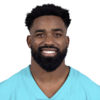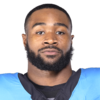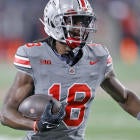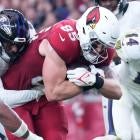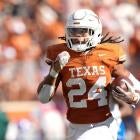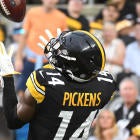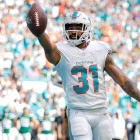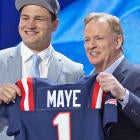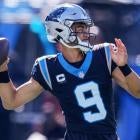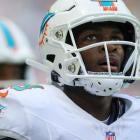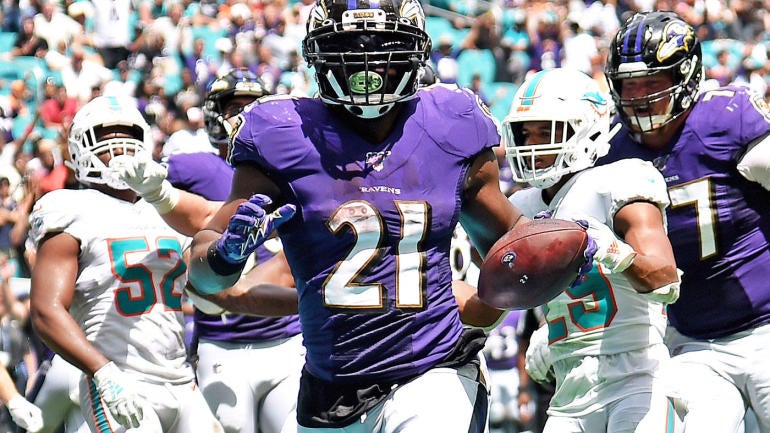
Regression isn't the most popular word to a lot of Fantasy Football players. It makes sense. When we talk about regression, we're often saying that the best performers from the previous season won't repeat their feats. However, it also means some players who were disappointing are probably going to be better. It would be much easier if we could just take one season's stats and apply them to the next year, but without accounting for regression, you might have taken Todd Gurley in the first round and been disappointed that he failed to repeat his 21 touchdowns from 2018.
I've done regression alert columns for years and this year's will be a four-part series, with separate articles for each position. That's because 2019 had a lot of outlier performances. When I set out to compile a list of regression candidates, I came up with more than 40 names across the four main Fantasy positions. Yes, some of 2019's best were there including Lamar Jackson, Aaron Jones, Chris Godwin and Mark Andrews. But there were plenty of middling players as well.
Here are the biggest regression candidates at running back:
Aaron Jones finished as the No. 2 running back in Fantasy last year largely due to his obscene 6.8% rushing touchdown rate. So he was going to be a regression candidate long before AJ Dillon ever came into the picture. The difficulty with Jones is he has always scored a ton of touchdowns. Before last year he had a 5.6% rate, and I was regressing that downward in my projections for 2019.
Oops.
Even with Dillon on the team, I expect Jones to earn close to 200 touches and 60 targets. Even dropping his yards per carry to 4.6 from his 5.0 career mark and his touchdown rate to 4.4% in my projections, Jones remains in my top-15 backs in both formats. Unfortunately, he's being drafted in the first round of a lot of 2020 Fantasy drafts. With the coming touchdown regression, that would be a mistake.
You would hope Raheem Mostert could make up for his upcoming regression with a big increase in work. But in Kyle Shanahan's three years in San Francisco only one back (Carlos Hyde) has topped 160 carries. Hyde had 240 in Shanahan's first year in San Francisco. With Tevin Coleman, Jerick McKinnon and Jeff Wilson all still on the roster it's hard to imagine Mostert getting anywhere close to 240. That's a problem because he's also not likely to get close to last year's 5.6 yards per carry and 5.8% touchdown rate.
It's easy to look at his career numbers and think maybe Mostert is just a hyper-efficient back. But Mostert has just three more carries in his career than Lamar Jackson had in 2019. An optimistic projection for Mostert would put him at 4.9 yards per carry and a 4.0% touchdown rate. Considering his lack of involvement in the passing game, that's going to mean Mostert needs 200 carries just to crack the top 24 running backs. That's not the type of upside you should look for on Draft Day.
Mark Ingram's entire 2019 season could be a lesson in extreme efficiency. Unfortunately, his 2020 season may be more about the effects of age and regression. Ingram's yards per carry (5.0), touchdown rate (5.0%) and yards per target (8.5) were all well above both the league median and his career average. But it's the receiving touchdown rate (five scores on 29 targets) that is just ridiculous. How ridiculous? Ingram played eight years with Drew Brees before 2019. He saw 286 targets in those eight years and caught five touchdown passes.
I've regressed Ingram's touchdown rate on both runs and catches back to 4.0% and his yards per carry back to 4.6. That keeps him outside of my top-24 backs in PPR at 215 touches, and there is significant risk J.K. Dobbins takes more work than Gus Edwards did last year. In non-PPR, Ingram is more interesting as a low-end No. 2 back.
Honorable Mention:
Todd Gurley (5.4%), Christian McCaffrey (5.2%) figure to see a drop in their rushing touchdown rate. But I wouldn't worry about it too much. McCaffrey can lose 50 Fantasy points and still be the No. 1 back. And I have some hope an increased role in the passing game in Atlanta can make up for Gurley's losses.
It's Not All Bad
I shouldn't make this a different section, but I'm tired of fighting about it. Positive regression and negative regression are the same thing; regression. If a player's efficiency improves towards league average or his career norms, that is regression. And it should happen for these guys in 2020.
I've come to accept Alvin Kamara is just going to be in this article every year, one way or another. After his rookie year I said there was no way he'd average 6 yards per carry or 10 yards per reception again. He didn't, but a 7.2% rushing touchdown rate softened the blow and kept him among the top four at the position. Last year I said he couldn't repeat that touchdown rate, and boy did he really fall short. Kamara touched the ball 252 times and scored just six touchdowns. His receiving touchdown rate was barely above 1.0%. It's time for him to show that regression works both ways.
I have Kamara projected for 12.7 total touchdowns on 282 touches in 2020. That's a rate in between his outlier 2018 and his outlier 2019. I also expect he'll bounce back in terms of target efficiency as well. Kamara said his leg was only at 75% in 2019, which may explain why his yards per target fell to a career-worst 5.5. This makes him an easy top four pick in PPR and someone I'd take over both Dalvin Cook and Ezekiel Elliott in that format.
It's always tough for me to trust a Doug Pederson running back, but Miles Sanders has an enormous opportunity in front of him. As good as Sanders' was as a rookie, he had just a 1.7% touchdown rate. If he's really the team's lead back in 2020, you should expect that number to double, at least. Jordan Howard had a 5.0% rate before he got hurt and the team has scored on more than 3.0% of their carries each of the past two seasons. I have Sanders projected for 261 carries, so even a 3.0% rate gets him to 7.8 rushing touchdowns and makes him a top-12 running back.
Honorable Mention:
- Kerryon Johnson had better hope 3.6 yards per carry regresses quickly or he could lose his job early to D'Andre Swift. For what it's worth, Johnson averaged 5.4 YPC as a rookie.
- Matt Breida has never been a big touchdown guy, but he scored once on 123 carries last year. He has an opportunity in Miami and should absolutely improve on that 0.3% touchdown rate.
It's Complicated
Coming regression can be mitigated by a variety of factors, both good and bad. Or regression can happen to two different numbers that cause a net neutral result. It's kind of frustrating to parse, but it's worth talking about. Here are some quick hitters on the complicated cases:
- Le'Veon Bell had a career-worst yards per carry (3.2) and rushing touchdown rate (1.2%). His receiving touchdown rate (1.3%) and his yards per reception (7.0) were also well below his career norms. Part of that is just how bad the Jets were/are. But if you promised me Bell was getting more than 300 touches again I'd tell you he should be a late second round pick in PPR. Unfortunately the Jets have Adam Gase and now they also have Frank Gore. So we'll just have to wait and see.
- Leonard Fournette scored three times on 265 carries. Think that's bad? He earned 100 targets and didn't reach the end zone once. And he still finished as a top-10 running back. Normally I'd call Fournette a steal in the third-round, but very little looks the same in Jacksonville. Jay Gruden replaced John DeFilippo, the team added third-down back Chris Thompson and reportedly tried to trade Fournette before the NFL Draft. Like Bell, if Fournette gets close to the same number of touches, he'll be a lot better, we just can't count on the touches.
- Dalvin Cook probably can't repeat a 5.2% rushing touchdown rate, but he likely won't have zero receiving touchdowns either. We just need him to stay healthy.
- I would like to say Derrick Henry can't repeat 5.1 yards per carry and a 5.3% touchdown rate, but I'm getting kind of tired of doubting the dude. My current projections have him at a 4.0% touchdown rate and 4.6 YPC. They also have him leading the NFL in rushing touchdowns and third in rushing yards.
- Neither Jordan Howard (5.0%) nor Kenyan Drake (4.7%) should be expected to repeat their rushing touchdown rate from last year. But if they both get 16 games as a feature back, we can live with that. Like Cook, Drake should actually score a receiving touchdown this year.









